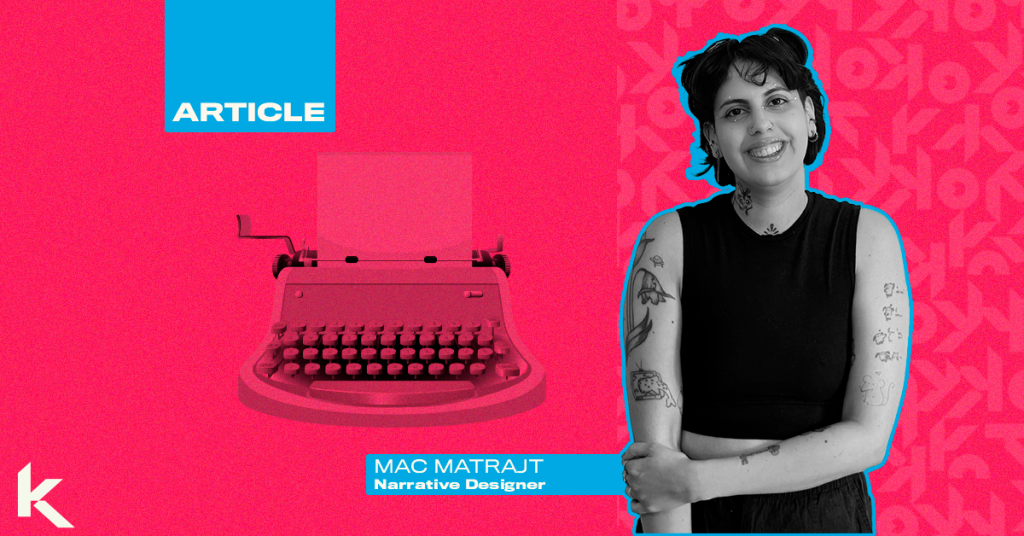By Mac Matrajt, Narrative Designer
Whenever someone asks me what I do for a living (to which I quietly answer “I’m a writer…”), I brace myself to hear:
“Oh! You must be so creative!” or “I’m terrible at writing, I can’t put any of my thoughts onto paper”, and for those, my answer will always be “Well, writing is a muscle! If you don’t work at it daily, it kinda goes away…”
When I was teaching a first-semester screenwriting class at this animation and illustration university, I used to open the first class with a quick QA. A lot of my students’ curiosity lay in how a day-to-day creative job was, and they were excited to, in the future, work with something they felt they could do every day (like drawing). I used to tell them the raw reality of having a creative job: it is more about choosing a methodology and understanding the client’s wants, the project’s needs, and how I can build into that, than being crazy creative.
As a Narrative Designer, an essential part of my job is grasping the project I’m working on, the client, the future players, and the expectations for the story I’ll be telling. An obstacle many writers go through whenever they work inside a company/studio that serves a creative product is: we might get on board a project as the last soldier- the project might be half done or almost completed by the time we get the “hey… the client wants some narrative on here!” message.
Your biggest weapon as a writer will always be to “stay curious” and to open communication with the team by asking questions. At Kokku, I’m part of a creative team of skilled Game Designers- and my first questions to them might be about references the team might have for the narrative if the client delivered any “wants, needs, and don’ts” documents if a demo or a previous game exists, and if I can play it to get a feel of the mechanics and the already existing narrative (if it happens to be based on another game).
After the questions are asked and answered, I dump all the information to get to research!
Yes, research. And I’m not talking about the modern sense of it where you get to ask Chat GPT for the answers to your questions. I mean the embarrassing “I will delete this search history later”, roll up your sleeves, deep search vibe on YouTube, blogs, books, and whatever Google can help you find.
Now, you might be thinking: “Oh Mac, so that’s the writer’s secret? Search on Google?” No, no… but it is a healthy, curious, straightforward foundation any writer has. After I get my hands on the information the client and the team provide and I set the narrative goals, references, and the study/board of the future players, it is time for my brain to focus on building.
My objective as a narrative designer is to grab those blobs, colors, shapes, and angles of information and start placing them in a way that creates a structure. Some writers believe writing without the bonds of a structure invites creativity to flow better, but I feel it’s easier to write when I can see the pillars of the story I want to tell.
We can think of “structure” in the narrative designer area as in: the genre, the players who play similar games, the IP of the client, the mechanics, and the competition. Having that information in place I can start brainstorming narrative ideas and the way I can/want to develop them- an easy example of this would be thinking of how I want the player to explore the story, through items, the texts in the UX/UI, by having choices, by giving the game a narrator, unreliable or not, or by the main character’s (in this case the player) perspective. The decision I’ll make on how the player will live and walk through the story is the most important one in this creative development.
I always joke about how writing is just editing. Once we have the idea down and written, it is time to get feedback and tweak it. Feedback becomes essential because, as writers, we get so used to the words and the way we present them that at some point, we lose sight of what we are trying to communicate. Presenting the story and how we want it developed to other team members can help us understand what parts are clear and working and which ones need to be edited or dropped. It isn’t to reach perfection, we also have to know the right timing to let an idea be- flaws and all.
On paper (or on a screen), all of these tools to develop a narrative for games might seem too straightforward. One of the many things my job at Kokku has taught me is to yes, rely on curiosity, research, structure, and feedback- but also to make room for a newfound creativity in the chaos that developing casual to AAA games can bring. After all, we are creating entertainment, and whenever we get to pitch a story with quest dialogs, copy, branching, or screenplays, we can´t forget the “fun” element we, as narrative designers, get to bring to player agency.
In conclusion, writing is a creative process with no right or wrong. Creativity can live without boundaries or structures, but it can also thrive in the presence of both. Getting information, doing research, and establishing the objectives of a project are part of being a narrative designer, but creating a story worth experiencing is a writer’s dream.
